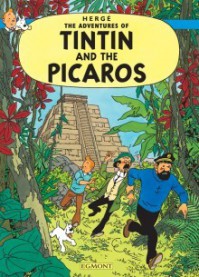South American Revolutions

This is the last of the completed Tintin books and in a way does finally tie everything up. Granted, nobody ever lives happily ever after, but I do feel that it does round off and complete what I consider to be a ground breaking series of books that are incredibly funny and very entertaining. This album seems to follow on after the Castafiore Emerald as there are a few connections with the events in the previous album, however it appears that Flight 714 occurred between the two albums. Now while this is possible (as Bianca Castafiore is on a tour of Latin America that she began at the end of the Castafiore Emerald) I feel that the events of Flight 714 should probably come afterwards.
As mentioned, Bianca Castafiore, with her entourage, are traveling through Latin America and arrive at the fictional country of San Theodoros (the same country from The Broken Ear) and she and her entourage (which includes Thompson and Thomson) are arrested immediately after the concert on the grounds of participating in a conspiracy to overthrow the leader General Tapioca. What drags Tintin and his friends into the fray (other than the fact that their friends are in danger) is that General Tapioca is aware that prior to her tour, she had stayed with Captain Haddock and Tintin at Marlinspike, and that it was while they were there that the conspiracy was hatched. This is a very clever plot device Herge uses, which creates continuity in the albums. However, the story of Alcazar and San Theodoros has been sitting in the background since The Broken Ear, and it is only resolved here, at the end.
Herge does deal with alcoholism, particularly among native populations, in this album. We once again meet the Arumbaya and the white anthropologist who has decided to live with them. However, as a way to keep the native populations and the rebels suppressed, General Tapioca has been parachuting crates of alcohol into the jungles. This is important, and shows how skillful a storyteller Herge is, because right from the beginning Captain Haddock has suddenly lost his taste for alcohol. In fact, it is very amusing watching the Captain swear that he is being fed poison while everybody else is amazed at how wonderful the whiskey is. I won't mention what is going on because it will destroy a very subtle plot device.
This story is much greyer than many of the others because we have Tintin being involved in an attempted coup, however true to his character, he refuses to allow anybody to be killed, despite tradition being that after every revolution, the previous ruler and his inner circle are supposed to be killed. This is not always the case though, since many go into self imposed exile. We are see the dichotomy of the South American countries, as they fly into Tapiocapolis, they fly over a modern central business district, and then over the slums being patrolled by disinterested police. However, the catch is that after all has been said and done, when they are leaving, the fly back over the same slums, however the only difference is that the sign, instead of saying 'Viva Tapioca' it says 'Viva Alcazar'.
Sometimes I wonder why Alcazar is really Tintin's friend. He is not really the type of person that Tintin would really throw his lot in with. In the Broken Ear he was made Aide-de-Camp, however this was to enable him to complete his mission in locating the stolen fetish. Other times Alcazar seems to be more interested in other things, and in particular, in the Red Sea Sharks, is involved in shady business dealings with Dawson, one of Herge's villains. It is clear in this album though that Tintin has not come over to San Theodoros to put his friend back in power, but rather to rescue friends who have been locked up on bogus charges. Unfortunately, what is required is a change of government, so true to Tintin, he looks for a plan that will succeed with little, and preferably no, bloodshed.
 2
2


